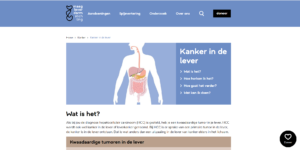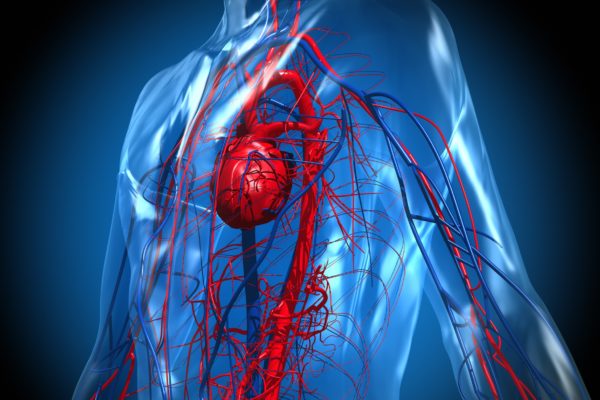
Maag lever darm stichting – MLDS (NL)
Cancer patients frequently present tumorous growths in the liver, but these are often metastases of cancers that originated elsewhere in the body. Only when a tumour develops in the liver out of liver cells, is it called a primary liver cancer.
There are several different types of liver cancer, but in 9 out of 10 cases, it will be a hepatocellular carcinoma. Other types include:
The liver plays an important part in absorbing nutrients from the blood and transforming them into enzymes and other useful matter. The liver also stores sugars and vitamins. Around 600 physical processes take place in the liver.
Hepatocellular carcinoma (HCC) is a tumour that grows from the hepatocytes, the most common liver cells. In 80% of patients, an underlying liver condition is present, in many cases cirrhosis. In this article, only HCC will be described.
Liver cancer is a rare cancer type: in Belgium, liver cancer occurs in 1.3% of all cancer patients. Men run a significantly higher risk of contracting the disease than women. Cases of liver cancer in children are extremely rare. In 2015, three children under 14 years old were diagnosed with the disease.
Even though the survival rate of HCC patients has risen, the outlook is still not very good. Out of patients who were diagnosed in stage A, 55% survives after 5 years, dropping off to just 2% for stage D patients.
Like many other cancers, liver cancer tends to go unnoticed during its early stages due to a lack of symptoms. By the time the illness is discovered, it may well have moved past the stage of viable treatment. Symptoms that do occur are:
As the tumour grows, it impairs the liver function. This prevents toxins from being processed, and consequently, these build up in the liver and other organs, causing fatigue, confusion and other symptoms.
Around 80% of all HCC patients present liver damage of some sort, usually cirrhosis due to lifestyle choices or previous illness.
Cirrhosis of the liver can be caused by:
A GP who suspects HCC in a patient will conduct a physical examination first and possibly do a blood test. If the outcome suggests the patient has a liver failure, the patient will be referred to a specialist. This specialist may conduct the following tests in order to reach a diagnosis:
To denote the stage of the cancer, the ‘Barcelona Clinic Liver Cancer Group’ method is commonly applied. This method includes indication about the degree of cirrhosis.
The stage is determined on the basis of factors such as:
When the cancer stage has been determined, a treatment plan will be devised. This can include: transplant, surgery, radiofrequency or microwave ablation, transarterial chemo-embolisation (TACE), radio-embolisation or targeted therapy.
If a patient is diagnosed during the early stages of HCC, curing is often still a possibility. Surgery will be the first choice, but when this is not an option, a transplant, radiofrequency ablation (RFA) or microwave ablation (MWA) can be considered. RFA and MWA are therapies based on radio- or microwaves that generate heat through oscillation, thus destroying cancer cells. For patients with locally advanced or metastatic disease, VEGF and kinase inhibitors may also be an appropriate option. Research into targeted therapies, such as these inhibitors, are currently under investigation.
A TACE can be performed as preliminary step towards a transplant. This is when the liver is temporarily disconnected from the body’s blood supply and chemotherapy agents are delivered to the tumour via the liver’s blood vessels.
However, if the cancer has reached stage B or further, curing is no longer an option, and all that remains is palliative care. Therapies that are offered include:






